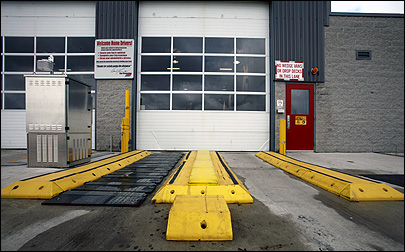Residents of most towns and cities depend on garbage collection, school, public transportation and other basic services, but to provide these services, agencies and companies must first ensure their vehicles are up to the job. A school bus driver who discovers a flat tire in the morning might not be able to start his route on time. The same is true for garbage collectors and parcel delivery drivers.
Five years ago, Michelin North America rolled out a system by which mechanics of fleet trucks could automatically check the air pressure in a vehicle’s wheels after it was returned to its terminal or garage upon completion of a route. The eTire pressure and asset-monitoring system used passive RFID tags linked to pressure and temperature sensors. These sensors, mounted inside each tire, could be read either by antennas mounted low to the ground near the garage entrance, or by handheld readers carried by mechanics.

Keeping truck tires at optimal pressure is important not only to keep fleets of trucks on roadways, but also because trucks use more fuel when their tires are underinflated. For a large fleet of trucks driven daily, the energy savings achieved through monitoring tire pressure can add up quickly.
The sensor module used in the original eTire platform, introduced in 2002, contained a passive, low-frequency RFID tag utilizing a proprietary air interface. Provided by Texas Instruments (TI), the tag was physically integrated with a capacitive Micro Electro Mechanical Systems (MEMS) device to sense pressure and temperature. It was bulky—about the size of five or six credit cards stacked together—so Michelin recommend that trucks with the modules glued to their inside tire walls drive no faster than 50 miles an hour. At speeds higher than 50, Michelin warned, the sensor module might stop functioning properly, and the weight of the sensor module might cause wheels to rotate in an imbalanced manner.
Michelin is now rolling out a second-generation eTire platform, the eTire II, which features a significantly lighter shirt-button-sized RFID tag and sensor module designed to function correctly at higher speeds without causing any tire imbalance. This second-generation eTire sensor module incorporates temperature and pressure sensors made by Honeywell Sensing & Control‘s business unit, which employ surface acoustic wave (SAW) technology. It also contains an ultra-high frequency RFID inlay compliant with the ISO 18000-6b standard.
Such is needed because, unlike some SAW sensors, the Honeywell sensors do not include unique identifiers enabling them to function as RFID tags. Like the first-generation module, the device is glued to a sidewall inside each tire, either by the Michelin eTire dealer or by the end user. Once the sensor module is attached, by means of a strong adhesive, it cannot be removed or reused on a different tire. Marc Laferriere, vice president of marketing for Michelin Americas Truck Tires (a division of Michelin North America), says it can be glued to the interior sidewall of truck tires from any tire maker, not just Michelin’s.
Tracking temperature in addition to pressure is important, Laferriere explains, because by compensating for the pressure reductions caused by cold temperatures, fleet managers can collect pressure readings that are more accurate. This more accurate data can help identify slow leaks in tires more quickly than by tracking pressure alone.
Laferriere notes that other truck tire air-pressure monitoring systems, such as those sold by Dana, SmarTire Systems and Arvin Meritor, sensors mounted to wheel rims. Frequent application of the brakes, however, causes a trucks’ rims to become very hot. Therefore, he says, rim-mounted sensors are less likely to collect accurate temperatures inside the tires, or get accurate pressure readings.
Each truck using eTire modules also carries a UHF tag, placed inside its rear bumper, to identify the truck. The module’s ID numbers are associated with the truck tag’s ID number. Moreover, each tire’s tag ID number is associated with its wheel position (for example, right rear, or right rear inside, in the case of dual-wheeled trucks).
The system saves all of this information, along with the tire pressure data, and updates it each day whenever the sensor modules are read, in an Internet-based tracking software called BibTrack. This software allows fleet managers to monitor the tires from multiple terminals or garages, and to track those tires that frequently have flats or low pressure. Managers can use this information to weed out chronically leaking tires that might have a manufacturing fault. BibTrack was also part of the first generation of the eTire platform.
According to Laferriere, most fleet management companies that had been testing the first generation eTire sensor modules (which Michelin has ceased making) will now begin testing the second-generation tag, though they need to add UHF ISO 18000-6b interrogators to their systems to read the new sensor modules. Michelin North America is marketing the platform to companies in North America that maintain fleets of sanitation trucks, as well as managers of school bus and public transportation fleets.
Laferriere says pricing for the new sensor modules has not yet released, but will be comparable to that of the earlier version, which sold for $25 apiece. The eTire II platform is now available.

